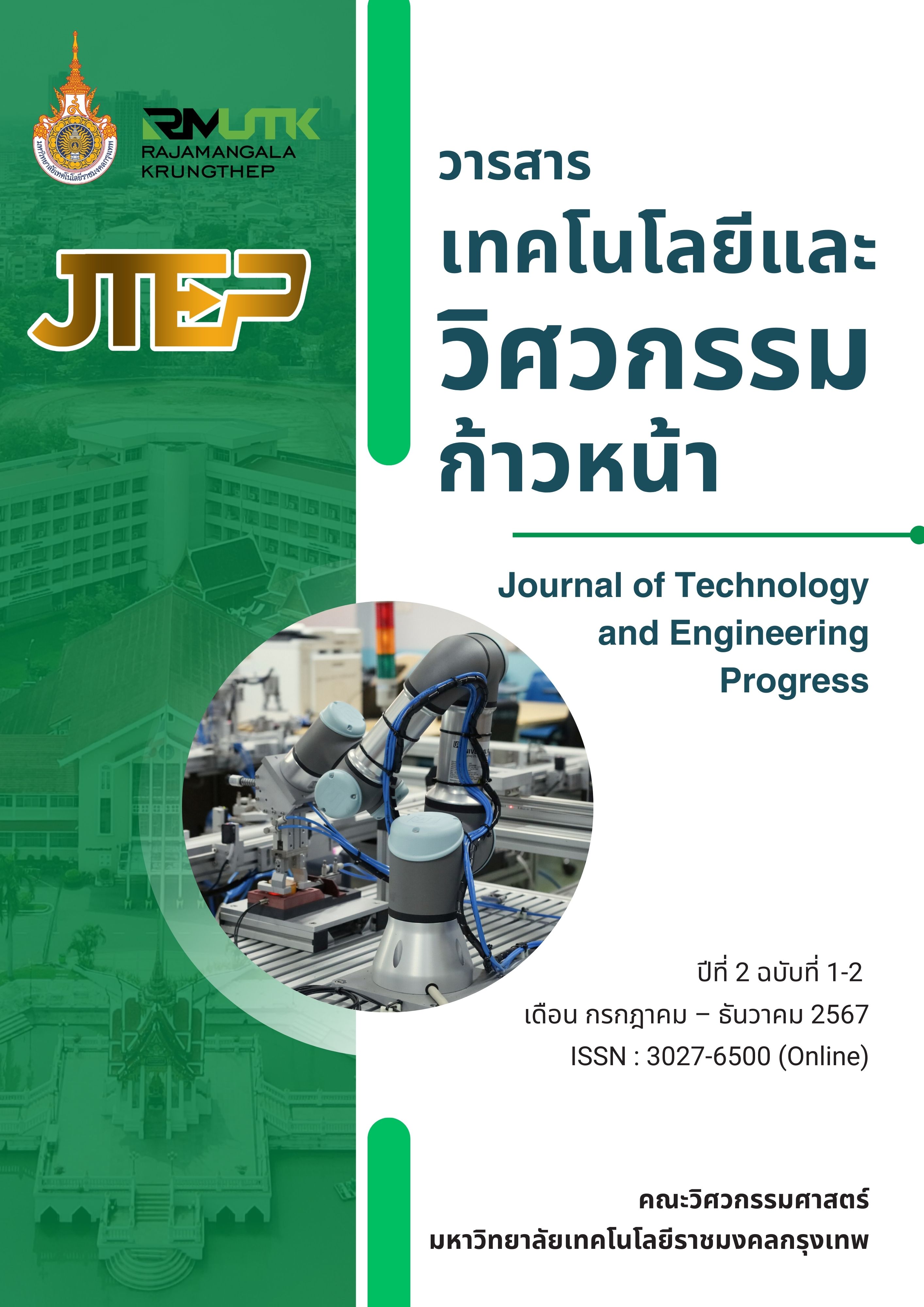ความแม่นยำของขนาดและการหดตัวของอะคริโลไนไตรล์บิวทาไดอีนสไตรีนในกระบวนการพิมพ์ 3 มิติ
Main Article Content
บทคัดย่อ
ปัจจุบัน การพิมพ์ 3 มิติ มีการใช้งานกันอย่างแพร่หลายในเทคโนโลยีการสร้างต้นแบบรวดเร็ว การสร้างชิ้นส่วนที่มีความแม่นยำของขนาดมีความสำคัญอย่างยิ่งสำหรับการผลิตชิ้นส่วนขนาดใหญ่หรือชิ้นส่วนประกอบที่ต้องการขนาดพอดีกัน ดังนั้นบทความวิจัยนี้จึงนำเสนอเกี่ยวกับผลกระทบของเปอร์เซ็นต์การเติมเนื้อวัสดุต่อความแม่นยำของขนาดและการหดตัวของชิ้นงานที่พิมพ์จากวัสดุอะคริโลไนไตรล์บิวทาไดอีนสไตรีน (ABS) การตรวจวัดขนาด 3 มิติ ใช้เครื่องสแกนตรวจวัดชิ้นงาน 3 มิติ และซอฟแวร์ GOM Inspect ในงานวิจัยนี้ใช้วัสดุ ABS รูปแบบเส้น เป็นวัสดุในการพิมพ์ ซึ่งมีขนาดเส้นผ่านศูนย์กลาง 1.75 มิลลิเมตร หัวฉีดขนาด 0.4 มิลลิเมตร ชิ้นงานทดสอบทรงกระบอกมีขนาดเส้นผ่านศูนย์กลาง 25 มิลลิเมตร สูง 25 มิลลิเมตร ใช้รูปแบบการเติมเนื้อวัสดุแบบลูกบาศก์ อุณหภูมิในการพิมพ์ 230 องศาเซลเซียส และความเร็วในการเติมเนื้อวัสดุ 30 มิลลิเมตรต่อวินาที เปอร์เซ็นต์การเติมเนื้อวัสดุ 5 ระดับ คือ 20%, 40%, 60%, 80% และ 100% จากผลการศึกษาพบว่าสามารถพิมพ์ชิ้นงานได้รูปทรงตามต้องการ มีค่าพิกัดความกลมและพิกัดความเป็นทรงกระบอกใกล้เคียงกัน ชิ้นงานที่ได้ในทุกตัวแปรมีขนาดเส้นผ่านศูนย์กลางเล็กกว่าขนาดที่กำหนด ที่เปอร์เซ็นต์ของการเติมเนื้อวัสดุต่ำ เกิดการหดตัวสูงและมีค่าความหนาแน่นน้อย ทำให้ความแม่นยำของขนาดน้อย เมื่อเปอร์เซ็นต์การเติมเนื้อวัสดุเพิ่มขึ้น เกิดการหดตัวน้อยลงและมีค่าความหนาแน่นสูงขึ้น ทำให้ความแม่นยำของขนาดเพิ่มสูงขึ้น
Article Details

อนุญาตภายใต้เงื่อนไข Creative Commons Attribution-NonCommercial-NoDerivatives 4.0 International License.
Journal of Technology and Engineering Progress is licensed under a Creative Commons Attribution-NonCommercial-NoDerivatives 4.0 International (CC BY-NC-ND 4.0) licence, unless otherwise stated. Please read our Policies page for more information
เอกสารอ้างอิง
A. J. Lopes, M. A. Perez, D. Espalin, and R. B. Wicker, "Comparison of ranking models to evaluate desktop 3D printers in a growing market," Additive Manufacturing, vol. 35, p. 101291, Oct. 2020.
B. Diallio. (2021, Nov 5). 3D Printer Filament Types. [Online]. Available: https://www.lpfrg.com/guides/3d-printer-filament-types/
J. White. (2021, Nov 5). How LEGO perfected the recycled plastic brick. [Online]. Available: https://www.wired.co.uk/article/recycled-lego-brick
A. Dey, D. Hoffman, and N. Yodo, "Optimizing multiple process parameters in fused deposition modeling with particle swarm optimization," International Journal on Interactive Design and Manufacturing (IJIDeM), vol. 14, pp. 393-405, Jun. 2020.
B. Rankouhi, S. Javadpour, F. Delfanian, and T. Letcher, "Failure Analysis and Mechanical Characterization of 3D Printed ABS With Respect to Layer Thickness and Orientation," Journal of Failure Analysis and Prevention, vol. 16, May. 2016.
H. Dave, B. Patel, S. Rajpurohit, A. Prajapati, and D. Nedelcu, "Effect of multi-infill patterns on tensile behavior of FDM printed parts," Journal of the Brazilian Society of Mechanical Sciences and Engineering, vol. 43, Jan. 2021.
A. M. Abdullah, D. Mohamad, T. N. A. T. Rahim, H. M. Akil, and Z. A. Rajion, "Effect
of narrow infill density gap on the compressive properties of 3D printed carbon fibre reinforced acrylonitrile butadiene styrene," Journal of Mechanical Science and Technology, vol. 33, pp. 2339-2343, May. 2019.
P. Żur, A. Żur, A. Baier, and G. Kokot, "Optimization of Abs 3D-Printing Method and Parameters,” European Journal of Engineering Science and Technology, vol. 3, pp. 44-51, Mar. 2020.
B. Akhoundi and A. H. Behravesh, "Effect of Filling Pattern on the Tensile and Flexural Mechanical Properties of FDM 3D Printed Products," Experimental Mechanics, vol. 59, pp. 883–897, Jan. 2019.
K. Alvarez, R. Lagos, and M. Aizpun, "Investigating the influence of infill percentage on the mechanical properties of fused deposition modelled ABS parts," Ingeniería e Investigación, vol. 36, pp. 110-116, Dec. 2016
Admin. (2019, Aug 31). Wrong dimension. [Online]. Available: https://www.sync-innovation.com/troubleshooting/problem-fdm-3d-printer/
P. Kankaew, “A study of shrinkage percentage acrylonitrile butadiene styrene based on the ASTM D955 standard test method,” RMUTP Research Journal, vol.12, pp. 148-157, Jul. 2018.
C. Studders, I. Fraser, J. W. Giles, and S. M. Willerth, "Evaluation of 3D-printer settings for producing personal protective equipment," Journal of 3D printing in medicine, vol. 5, pp. 133-144, Aug. 2021.
M. Adhitya, S. Sunarso, and A. Muis, "Comparison of Popular Three-Dimensional Printing Materials for Oral and Maxillofacial Surgical Guidance Model," Journal of Dentistry Indonesia, vol. 27, pp. 158-163, Dec. 2020.


